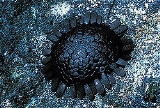
Shingle urchin
Encyclopedia
The shingle urchin or helmet urchin (Colobocentrotus atratus) is a species of sea urchin
in the family Echinometridae. In Hawaii it is known as "kaupali" which translates as "cliff-clinging". It is found on wave-swept intertidal shores in the Indo-West Pacific
, particularly on the shores of Hawaii
.
. It can grow as big as a soft ball but is usually much smaller. The upper surface is a mosaic of tiny polygonal plates formed from modified spines to form a smooth mosaic. This is fringed by a ring of large, flattened modified spines. On the underside there is another ring of smaller flattened spines and a large number of tube feet
.
fully exposed to waves and their associated abrasive
effect, often in groups. It feeds on periwinkle
s, other urchins and coralline algae
.
In a test comparing shingle urchins to other species of urchin, it was found that their ability to withstand being washed away by moving water excelled. A combination of their shape, their flattened spines and particularly the strong adhesion of their tube feet made them three times as resistant as other species such as Echinometra
. This enables them to live on inhospitable wave-battered shorelines.
Sea urchin
Sea urchins or urchins are small, spiny, globular animals which, with their close kin, such as sand dollars, constitute the class Echinoidea of the echinoderm phylum. They inhabit all oceans. Their shell, or "test", is round and spiny, typically from across. Common colors include black and dull...
in the family Echinometridae. In Hawaii it is known as "kaupali" which translates as "cliff-clinging". It is found on wave-swept intertidal shores in the Indo-West Pacific
Indo-West Pacific
The Indo-West Pacific, or IWP, is a zoogeographical region spanning the entire Indian Ocean including the Red Sea and the Pacific Ocean as far as the Caroline Islands but short of the Marshall Islands...
, particularly on the shores of Hawaii
Hawaii
Hawaii is the newest of the 50 U.S. states , and is the only U.S. state made up entirely of islands. It is the northernmost island group in Polynesia, occupying most of an archipelago in the central Pacific Ocean, southwest of the continental United States, southeast of Japan, and northeast of...
.
Description
This urchin is a deep maroon colour and shaped like a domed limpetLimpet
Limpet is a common name for a number of different kinds of saltwater and freshwater snails ; it is applied to those snails that have a simple shell which is more or less conical in shape, and either is not spirally coiled, or appears not to be coiled in the adult snails.The name limpet is most...
. It can grow as big as a soft ball but is usually much smaller. The upper surface is a mosaic of tiny polygonal plates formed from modified spines to form a smooth mosaic. This is fringed by a ring of large, flattened modified spines. On the underside there is another ring of smaller flattened spines and a large number of tube feet
Tube feet
Tube feet are the many small tubular projections found most famously on the oral face of a sea star's arms, but are characteristic of the water vascular system of the echinoderm phylum which also includes sea urchins, sand dollars and sea cucumbers and many other sea creatures.Tube feet function in...
.
Biology
This urchin is usually found on substratesSubstrate (marine biology)
Stream substrate is the material that rests at the bottom of a stream. There are several classification guides. One is:*Mud – silt and clay.*Sand – Particles between 0.06 and 2 mm in diameter.*Granule – Between 2 and 4 mm in diameter....
fully exposed to waves and their associated abrasive
Abrasion (mechanical)
Abrasion is the process of scuffing, scratching, wearing down, marring, or rubbing away. It can be intentionally imposed in a controlled process using an abrasive...
effect, often in groups. It feeds on periwinkle
Periwinkle
Periwinkle may refer to:In fauna:* Periwinkle, a common name for a number of gastropod molluscs in the family Littorinidae** Common periwinkle ** Blue periwinkle...
s, other urchins and coralline algae
Coralline algae
Coralline algae are red algae in the order Corallinales. They are characterized by a thallus that is hard because of calcareous deposits contained within the cell walls...
.
In a test comparing shingle urchins to other species of urchin, it was found that their ability to withstand being washed away by moving water excelled. A combination of their shape, their flattened spines and particularly the strong adhesion of their tube feet made them three times as resistant as other species such as Echinometra
Sea urchin
Sea urchins or urchins are small, spiny, globular animals which, with their close kin, such as sand dollars, constitute the class Echinoidea of the echinoderm phylum. They inhabit all oceans. Their shell, or "test", is round and spiny, typically from across. Common colors include black and dull...
. This enables them to live on inhospitable wave-battered shorelines.
External links
- http://jeb.biologists.org/cgi/reprint/199/3/717.pdf
- http://www.springerlink.com/content/9526t7n4h5647531/

